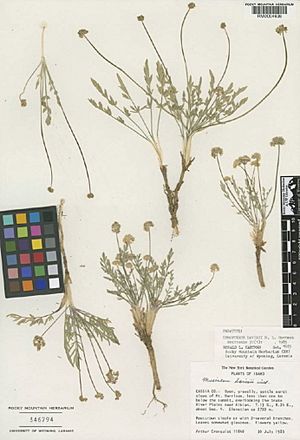Davis's springparsley facts for kids
Quick facts for kids Davis's springparsley |
|
|---|---|
 |
|
| Conservation status | |
| Scientific classification | |
| Kingdom: | |
| (unranked): | |
| (unranked): | |
| (unranked): | |
| Order: | |
| Family: | |
| Genus: |
Cymopterus
|
| Species: |
C. davisii
|
| Binomial name | |
| Cymopterus davisii R.L.Hartman
|
|
Cymopterus davisii is a special kind of flowering plant. It is often called Davis's springparsley. This plant belongs to the carrot family, just like carrots and parsley!
This small plant has a flat shape and a strong main root called a taproot. It is a perennial, which means it lives for more than two years. Davis's springparsley is endemic to Idaho in the United States. This means it grows naturally only in Idaho and nowhere else in the world! You can find it in the Albion Mountains.
Contents
What Does Davis's Springparsley Look Like?
Davis's springparsley is a small plant. It usually grows to be about 7 inches (18 cm) tall. It has a short stem that is covered by tough, fibrous bases from old leaves.
Many leaves grow in a circle around the stem. These leaves surround clusters of small, yellow flowers. These flower clusters are shaped like umbrellas and are called umbels.
Where Does This Plant Live?
This unique plant lives in the Albion Division. This area is part of the Minidoka Ranger District. It is located within the Sawtooth National Forest in Idaho.
Davis's springparsley prefers to grow in high mountain areas. These places are called alpine communities. Another special plant, Christ's Indian paintbrush, also grows in these same mountain areas.
How Was It Discovered?
The first time Davis's springparsley was collected was in 1939. It was found by Ray J. Davis. He was a professor who studied plants at Idaho State University.
However, it took many years to realize it was a new species. In 1985, Ron Hartman identified it as a new plant. He decided to name it after Ray J. Davis, who first found it.
Where Can You Find It Today?
Scientists know of three main groups, or populations, of Davis's springparsley.
- The two largest groups are found on Mount Independence and Mount Harrison. The group on Mount Independence is connected to another area near Cache Peak.
- There is also a smaller group of plants. This group lives further south, on Graham Peak.


